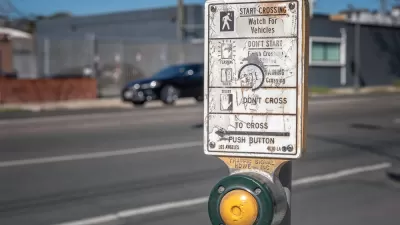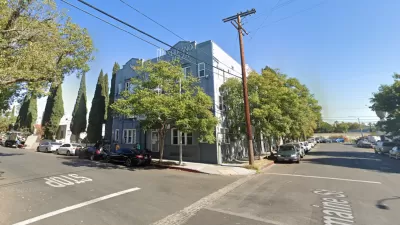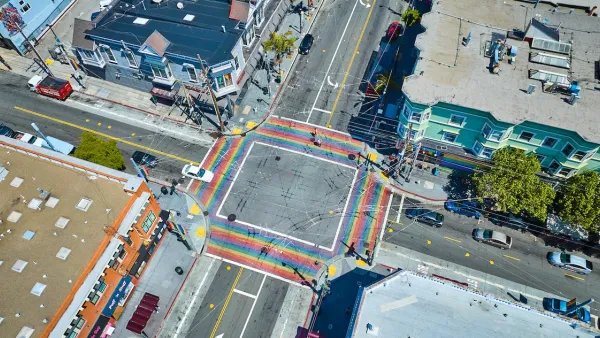In what is either a hopeful sign of the increasing prominence of the pedestrian, or a depressing comment on existing level of pedestrian safety, the installation of a crosswalk in downtown Los Angeles this week was big news.
Pedestrians in L.A. may no longer be able to play the Rodney Dangerfield card, as news this week indicates they're beginning to get some overdue respect. At an event downtown, Mayor Antonio Villaraigosa announced a new program to replace traditional pedestrian crossings with the more visible "continental" or "zebra" crosswalks throughout the city, reports Damien Newton.
"Continental crosswalks feature two-foot wide yellow or white painted stripes paired with a limit (stop) line setback from the crosswalk to reduce vehicular encroachment into the crosswalk," explains Newton. "The crosswalks alert motorists that they are approaching a pedestrian zone and are widely considered more safe than pedestrian crossings marked by two thin lines connecting two corners of an intersection."
“Los Angeles is in the midst of a transportation renaissance,” said Villaraigosa. “We are doubling the size of our rail network, making improvements to traffic flow and adding new bikeways. But we need to ensure that no one gets left behind. This focus on pedestrian safety is part of our efforts to create a 21st century transportation network that works for everyone.”
Although the mayor wants to update each of the 19,770 marked crosswalks in the city, he's settling for completing 53 by the end of March.
“We’re excited by today’s announcement,” says Deborah Murphy, the founder of Los Angeles Walks and Chair of the city’s official Pedestrian Advisory Committee. “This is the first of what we hope are many steps forward to make our streets safer for pedestrians.”
FULL STORY: City Officially Unveils “Continental Crosswalk,” Promises 50 More in Next Three Months

Planetizen Federal Action Tracker
A weekly monitor of how Trump’s orders and actions are impacting planners and planning in America.

Chicago’s Ghost Rails
Just beneath the surface of the modern city lie the remnants of its expansive early 20th-century streetcar system.

San Antonio and Austin are Fusing Into one Massive Megaregion
The region spanning the two central Texas cities is growing fast, posing challenges for local infrastructure and water supplies.

Since Zion's Shuttles Went Electric “The Smog is Gone”
Visitors to Zion National Park can enjoy the canyon via the nation’s first fully electric park shuttle system.

Trump Distributing DOT Safety Funds at 1/10 Rate of Biden
Funds for Safe Streets and other transportation safety and equity programs are being held up by administrative reviews and conflicts with the Trump administration’s priorities.

German Cities Subsidize Taxis for Women Amid Wave of Violence
Free or low-cost taxi rides can help women navigate cities more safely, but critics say the programs don't address the root causes of violence against women.
Urban Design for Planners 1: Software Tools
This six-course series explores essential urban design concepts using open source software and equips planners with the tools they need to participate fully in the urban design process.
Planning for Universal Design
Learn the tools for implementing Universal Design in planning regulations.
planning NEXT
Appalachian Highlands Housing Partners
Mpact (founded as Rail~Volution)
City of Camden Redevelopment Agency
City of Astoria
City of Portland
City of Laramie





























